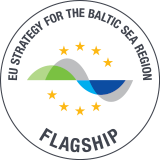Urban area
Visaginas is the centre of Lithuania’s youngest municipality, located on the north-eastern edge of the country. The city was planned and built as a support structure for the Ignalina nuclear power plant from 1975. Originally, the aerial view of Visaginas was designed to resemble a butterfly. However, as work on the nuclear power plant was later cancelled, so was further construction of the town.
Currently, Visaginas consists of three residential regions that locals refer to as the 1st, 2nd and 3rd Micro-districts. The town is very urban; almost all buildings are high rise and there is very little car traffic with only 14 streets. Mostly people move around by foot. Furthermore, there are a lot of green spaces, recreational areas and a lake. It is a very safe town with open green areas and pedestrian routes. Even today everything is well kept and managed. In many ways, it is a modernistic ideal city. There are a growing number of empty buildings – some of them are facing demolition soon, others are going to be turned into elderly housing.
Population
The town was built for the workers engaged in the construction of the Ignalina Nuclear Power Plant. People were recruited from the whole of the Soviet Union. This planned migration is a clear feature of the town. 43 different nationalities are represented in the city. Russian is the first language of the vast majority of town population. 19.776 population with increasing elderly segment and very high education. The population has declined two times in the last 40 years. The informal education institutions engage kids in various activities with extreme success up until they turn 16, then the engagement rate drops from 99.8% to 21%.
Challenges identified
The overall scenario of the city is how to address the long-term closure of the Nuclear Power Plant. This is the economic driver of the city and also the platform for the identity of the city. The closure of the plant is a slow process and estimated to take more than 20 years to come, because the consequence is already so visible in the city. In addition, Visaginas is segregated from the rest of the country, both physically and mentally.
Furthermore, issue of identity is very strong. The sense of belonging was lost after the fall of Soviet Union and the joining of EU. People identify more as “Europeans” than as “Lithuanians”. Closely related to this, there is no Lithuanian culture, the cultural sector is very much centralized and lacks innovation. The classical institutions such as the library, cultural centre and theatre get all the resources and funding from the state. Soft processes are not able to strive in this controlled environment. The municipality understands, that people should be involved in the production of cultural events, but on the national level the need is not identified.
On a national level, Visaginas is more identified with a sports function due to the closeness to the nature, lake and empty facilities. But this clearly ignores the intellectual property and potential of the local community.
Visions and aims
An overall aim is to formulate a new long term vision of the city. The City has a general vision to try to adapt to the new situation and to become a city with a high quality of life. This can be achieved by looking more innovatively at the positive aspects of the city.
Lena Buško – Director of Ignalina NPP Region Business and Tourism information centre – expresses that their vision is to repurpose the Ignalina Power plant into a data centre. The aim is to inspire businesses to relocate to Visaginas, and to give the younger people reason to stay here. Visaginas is a slow city, and this could be an asset to attract people who work remotely and wish like to enjoy a green and slow life, as well as the cheap rent and spaces for workshops etc.
Cultural planning approach
- Supporting a new trans-sectoral approach in the city.
- Offering mentoring and leadership training to teams and to cultural institutions.
- Testing prototypes for new key projects where science, technology, environment and culture can re-enforce concepts and formats.
- Engaging citizens, especially children and community resources, in open processes.
- Developing communication platforms to support new narratives, images and storytelling from Visaginas.
Documents
Diary of Visaginas click here.
Process booklet click here.
Baseline study click here.








